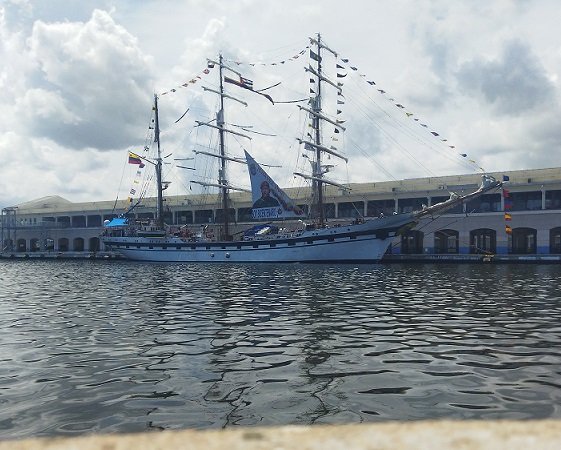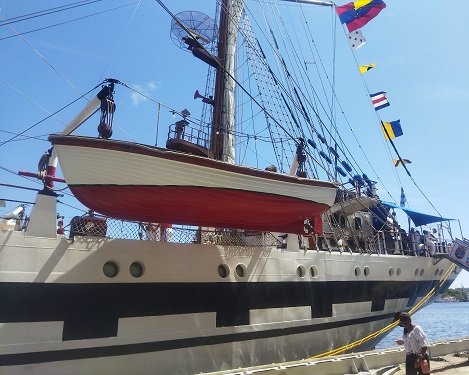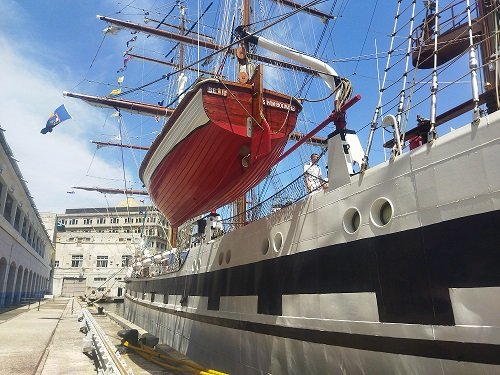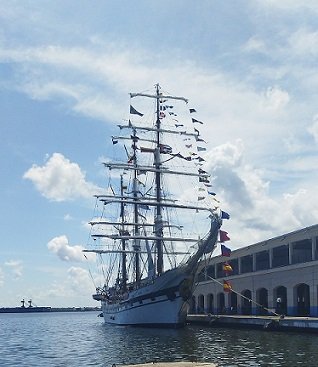3- Curisidades sobre otro Buque Escuela 🇻🇪 [SPA/EN]

SPANISH
Englis version is below
Hay algo mágico en los barcos, ¿no lo crees? El sonido de las olas chocando contra el casco, el viento y la sensación de estar navegando. Recientemente, el Buque Escuela "Simón Bolívar" (BE-11) de la Armada Nacional Bolivariana atracó en el puerto de La Habana, y hoy te invito a conocer un poco más sobre él. ¿Listo para zarpar en esta aventura?

Si sigues mi contenido, sabes que hace poco escribí sobre otro gran barco: el Cuauthémoc, mexicano. Pues en hace unos días, regresé al Puerto de La Habana. Con el objetivo de conocer otro espectacular buque, esta vez perteneciente a la Armada Venezolana. Así que volvamos al mar...

Esta vez, al ser día laborable e inicio de semana, me ahorre la cola para entrar (cosa para nada normal en Cuba) Enseguida entré por la Aduana hasta el embarcadero donde suelen atracar estos barcos. En menos de 5 minutos, ya estaba arriba del Buque Escuela "Simón Bolívar", la razón de este artículo.👇


La fabricación, fue encargada a los famosos Astilleros y Talleres Celaya S.A, en Bilbao (los mismos astilleros que vieron nacer al Cuauthémoc mexicano y un tercer hermano, que sirve a la Marina Ecuatoriana. Espero algún día, traértelo por aquí también).
Fue terminado y botado al agua en noviembre de 1979. No es, hasta el 12 de Agosto de 1980 que se le afirmó el Pabellón Nacional, convirtiéndolo de esta manera, en un venezolano más.
El buque, emula a un bergantín tipo bricbarca de tres mástiles con un total de 23 velas, tiene un largo (eslora) de 82,4 metros y un ancho (manga) de 10,6 mtros. Equipado con la más moderna tecnología disponible para la Armada Venezolana, poniendo a disposción de los caddetes la mejor instrucción posible.

En sus más de de 40 años de servicio, el buque ha visitado más de 42 países entre América y Europa y ha tocado más de 100 puertos diferentes, recorriendo mas de 400 mil millas naúticas, lo que equivale a darle la vuelta al mundo arlededor del Ecuador aproximadamente 10 veces.
En esta ocasión, el Buque zarpó del puerto de La Guaira, el pasado 12 de abril, con una ruta que abarca varios países latinoamericanos(🇧🇧🇰🇳🇨🇺🇲🇽🇻🇪. Esta travesía, da inicio al 33 Crucero de Instrucción al Exterior Caribe 2023, luego de estar en dique seco a causa de la pandemia.


Si no eres latino, tal vez este nombre no te suene. Así que te hago un breve resumen.
El barco, lleva ese nombre, en honor a uno de los héroes más importante de la historia de América Latina, venezolano de origen. Este señor, conocido como "El Libertador", lideró grandes batallas con el objetivo de independizar los territorios que hoy corresponden a: Venezuela, Colombia, Ecuador, Perú, Bolivia y Panamá. En aquel entonces, establecería la Gran Colombia como una república unida, al independizarla del dominio español. Esto solo es un resumen muy corto de la toda la historia que guarda esta figura histórica. Te exhorto a seguir investigándolo, tal vez te gusté lo que descubras.


En este punto, si no has leído mi anterior artículo, te recomiendo que lo hagas. (Si lo leíste, puedes obviar este apartado)

Si eres nuevo por aquí, al mirar las imagenes, seguro te llama la atención su color blanco, poco común para un barco de una marina. Debido a que es un Buque Escuela, no está pensado para entrar en combate, todo lo contrario para ser llamativo. Otra de las razones de su color, se debe a su categoría de "Embajador Sin Fronteras" llevando un mensaje de paz y amistad a aquellos países donde toca puerto.
Otra razón de su color, es más por conveniencia; el blanco refleja la luz más fácil y permite mantener un clima cálido en su interior.

Campanas:Como curiosidad rápida... te cuento que el barco tiene dos campanas de tamaño mediano, no muy grandes, pero de gran utilidad.La primera, ubicada en la cubierta principal es utilizada para marcar la horaLa segunda, está en el Trinquete (el mástil que más alante está),se utiliza durante las guardias, sobretodo en la noche, para avisar al timonel de algún peligro o embarcación pequeña que dada la disposición del barco, el timonel puede no ver, evitando asi alguna colisión.


En internet aparece muy poca información sobre el escudo, lo que te relato a continuación me lo contó "mi guía" para la ocasión.

Escudo de Armas del BE "Simón Bolívar"
El escudo, contiene es su parte superior una corona naval dorada, representando el estatus y la importancia de la Armada Nacional Bolivariana, corona que tiene inscrito el nombre del Buque: Simón Bolívar.
Inmediatamente debajo, vemos 7 estrellas (las mismas que aparecen en la Bandera venezolana) La cadete me explica que cada estrella representa a una de las 7 provincias que firmaron el Acta de Independencia de Venezuela (si recuerdo bien: Barinas, Caracas, Barcelona, Cumaná, Margarita, Mérida y Trujillo)
Si encuentras algun error o quieres añadir algo no dudes dejarlo en los comentarios.
Por debajo encontramos un timón dorado (a primera vista pudiera parecer uno normal pero está inspirado en el timón del buque) y significa la dirección y control del barco.

Timón principal del barco
Más abajo, se ve un mapa del mundo; donde está resaltado en dorado, la nación Venezolana, representando a la Patria y al pueblo que sirve el "Simón Bolívar".
Finalmente, debajo se ve una representación del Buque.
Todo esto sobre un fondo azul, que por supuesto representa el cielo y el mar.
Por fuera del escudo, se observan dos anclas, clara representación de las dos anclas que posee el buque ( en otros barcos,se usa el sistema de un ancla) las que simbolizan la estabilidad y seguridad del buque.
Por el lateral, se puede leer la Inscripción (de izquierda a derecha) Buque Escuela- Armada de Venezuela, de la cual forma parte.

Botes salvavidas:Como otra curiosidad rápida... A bordo del barco, pude contar más de 10 botes salvavidas y dos bastante antiguos, que dijeron, están en uso (yo creía que eran elementos decorativos😅) y los demás inflables, con la más moderna tecnología y con capacidad cada uno para 5 personas. Mi "guía", me explicaba que el barco está en la obligación de tener botes salvavidas para el doble de la tripulación existente. Es decir, en esta ocasión navegan alrededor de 70 tripulantes, debe haber capacidad en los botes para 140 personas (estos números son un ejemplo, para nada son la cifra real)



Ya llegando al final de este tour, debo decirte que si este barco llega al puerto de tu ciudad ve a verlo, es toda una maravilla poder abordarlo. Los tripulantes son sumamente educados y tratan de hacerte sentir que estás en un lugar único, tanto así, que todos se ofrecen para darte un tour por el barco. La atención y los relatos que cuentan, hacen que olvides que estas en un buque de la marina.
En mi caso, la cadete que me atendió, me explicó los nombre de la mayoría de los elemntos del barco, me hizo una demostracion de como subían a los palos, la distribución del barco con su triple cubierta y todas las curiosidades que ya te comenté. En fin, que te recomiendo su visita.

Cubierta donde se encuentra la cocina, donde están expuestas un ancla y una hélice antigua del propio buque

Y hasta aquí nuestra visita al segundo Buque Escuela, que atraca en el Puerto de La Habana en un mes. Tienes ambos aquí en Hive, así que no hay justficación para no conocerlos.
Si quieres seguir leyendo sobre temas interesantes, sígueme (aún más si eres amante de los motores, puedes estar seguro que no te arrepentirás 😉)
Ah, no seas tacaño y comparte el contenido para que más personas se enteren de esta historia.😅
Hasta lo próxima, hiver 👋...

Todas las fotos fueron tomadas con mi teléfono.
Los banners y los separados fueron hechos por mí en Canva.

ENGLISH
Isn't there something magical about ships? The sound of waves crashing against the hull, the wind in your hair, and the feeling of sailing away into a world of endless possibilities. Recently, the "Simón Bolívar" (BE-11) training ship of the Bolivarian National Navy docked at the port of Havana, and today I invite you to learn a little more about it. Ready to set sail on this adventure?

Hey there, if you've been keeping up with my articles, you might remember my recent piece about the impressive Mexican vessel, the Cuauhtémoc. Well, I'm back at the Port of Havana again, this time to check out another magnificent ship that belongs to the Venezuelan Navy. So, let's get ready to set sail and explore the high seas once more...

This time, since it was a typical workday and the start of a fresh new week, I lucked out and didn't have to wait in line (which, let's be honest, isn't the norm in Cuba).. I went straight through Customs to the pier where these ships usually dock. Within less than 5 minutes, I was already on board the "Simon Bolivar" training vessel - the very reason for this article. Let's dive in and explore this ship!👇


The manufacturing of the "Simon Bolivar" was entrusted to the renowned shipyards and workshops of Celaya S.A, located in Bilbao (the same shipyards that gave birth to the Mexican Cuauhtémoc and a third sibling, which serves the Ecuadorian Navy. I hope to bring that one to you someday too...)..
The vessel was finished and launched in November of 1979, but it wasn't until August 12th, 1980 that it was proudly hoisted with the Venezuelan flag, officially becoming a part of the country's naval fleet. Let's dive deeper and explore the fascinating history of this remarkable vessel!
The "Simón Bolívar" is modeled after a three-masted brigantine with a total of 23 sails, measuring an impressive 82.4 meters in length and 10.6 meters in width. Equipped with the most advanced technology available to the Venezuelan Navy, it offers cadets an unparalleled training experience.

In its over 40 years of service, the "Simón Bolívar" has visited more than 42 countries across the Americas and Europe, and has docked in over 100 different ports, covering more than 400,000 nautical miles - which is roughly equivalent to circling the globe around the equator about 10 times!
The "Simón Bolívar" departed from the port of La Guaira on April 12th, embarking on a journey that will take it through several Caribbean countries(🇧🇧🇰🇳🇨🇺🇲🇽🇻🇪). This voyage marks the start of the 33rd International Instruction Cruise of the Caribbean 2023, after being in dry dock due to the pandemic.


If you're not from Latin America, you might not be familiar with the name "Simon Bolivar". So, here's a quick summary to bring you up to speed.
The ship is named after one of the most important heroes in Latin American history, who was of Venezuelan origin. This gentleman, known as "The Liberator", led great battles with the aim of gaining independence for the territories that now correspond to Venezuela, Colombia, Ecuador, Peru, Bolivia, and Panama. At that time, he established Gran Colombia as a united republic, freeing it from Spanish rule. Of course, this is just a brief summary of the rich history surrounding this historical figure. I encourage you to keep exploring, as you may be fascinated by what you discover.


At this point, if you haven't read my previous article, I highly recommend that you do so. (If you have already read it, you can skip this section.) Let's continue our journey and explore more of the fascinating history behind the "Simon Bolivar" training ship!

If you're new to this topic, you may notice that the "Simón Bolívar" training ship stands out with its striking white color, which is not a common choice for a naval vessel. This is because, as a training ship, it is not meant for combat but rather to be visually appealing. Additionally, it is designated as an "Ambassador Without Borders", carrying a message of peace and friendship to the countries it visits.
The white color of the vessel serves practical purposes as well. It reflects light more easily, allowing for a warmer interior climate. Let's delve into more of the functional features of this stunning vessel!

Bells:As a quick fact, the ship has two medium-sized bells, which are not very large but are incredibly useful....The first bell, located on the main deck, is used to mark the time...The second bell is located on the foremast (the mast located furthest forward) and is used during watches, especially at night, to warn the helmsman of any danger or small boats that may not be visible due to the ship's layout, thus avoiding a collision.


There is very little information online about its coat of arms However, during my visit, my guide shared some fascinating insights about it with me. Let's take a closer look at the design and symbolism behind this unique emblem....

BE "Simón Bolívar"´s Coat of Arms
The shield features a golden naval crown at the top, representing the status and importance of the Bolivarian National Navy, with the name of the ship, "Simon Bolivar", inscribed on the crown. Let's delve deeper into the symbolism and meaning behind the other elements of the shield.
Immediately below the crown, we can see seven stars (the same ones that appear on the Venezuelan flag). According to my guide, each star represents one of the seven provinces that signed the Act of Independence of Venezuela (if I recall correctly: Barinas, Caracas, Barcelona, Cumaná, Margarita, Mérida, and Trujillo)
If you notice any inaccuracies or have additional information to share, please don't hesitate to leave a comment below. We welcome and appreciate your input as we strive to provide the most accurate and informative content possible.
Below the stars, we can see a golden rudder (which may appear to be a normal rudder at first glance, but is actually inspired by the rudder of the ship), symbolizing the direction and control of the vessel.

The main helm of the ship
Further below, we can see a map of the world, with the nation of Venezuela highlighted in gold, representing the homeland and people served by the "Simón Bolívar". Let's move on to the final element on the shield.
At the bottom of the shield, there is a representation of the "Simon Bolivar" training ship.
All of these elements are set against a blue background, which of course represents the sky and the sea - two essential elements for any maritime vessel.
Outside of the shield, we can see two anchors, a clear representation of the two anchors that the ship carries (other ships typically only carry one anchor). These anchors symbolize the stability and safety of the vessel, which are essential for maintaining a secure and reliable ship at sea.
On the side of the ship, you can read the inscription (from left to right) "Training Ship - Bolivarian Navy of Venezuela", of which it is a part. This inscription serves as a clear indication of the ship's purpose and affiliation, proudly displaying its role as a training vessel for the Venezuelan Navy.

Lifeboats:As another interesting fact, I had the opportunity to observe more than 10 lifeboats on board the ship, including two older boats that are still in use (which I initially thought were just for decoration). The rest of the lifeboats were inflatable and equipped with the latest technology, with a capacity of up to 5 people each. The cadet explained to me that the ship is required to have lifeboats for double the number of crew members on board. For example, if there were around 70 crew members on this voyage, there would need to be enough capacity in the lifeboats for 140 people (these numbers are for illustration purposes only and not the actual figures).



As we come to the end of this virtual tour, I highly recommend that if the "Simón Bolívar" ever visits a port in your city, be sure to go and see it because it is truly a marvel to behold. The crew members are incredibly polite and go out of their way to make you feel like you are in a unique and special place. They are more than happy to take you on a tour of the ship and share their stories and experiences, which are sure to leave a lasting impression. The attention they give to visitors is remarkable, making you forget that you are on a naval vessel. Don't miss the opportunity to experience this remarkable ship and learn more about its fascinating history and culture if you ever have the chance to do so.
During my visit, the cadet who assisted me was very knowledgeable and enthusiastic about the ship. She explained the names of most of the ship's elements, demonstrated how to climb up the masts, and showed me the layout of the ship's triple deck. She also shared many interesting facts and stories about the ship. Overall, I highly recommend a visit to the "Simon Bolivar". The crew members are very passionate about the ship, and they are more than happy to share their expertise and experiences with visitors. Don't miss the opportunity to learn more about this remarkable vessel and its fascinating history and culture.

The deck where the kitchen is located also features an antique anchor and propeller from the ship on display.

And that concludes our visit to the second training ship, which will be docking at the Port of Havana in one month's time. Both ships are featured here on Hive, so there's no excuse not to get to know them better! I strongly encourage you to explore these remarkable vessels and learn more about their rich history and culture. Who knows, perhaps one day you'll have the chance to see them in person and experience their majesty and beauty firsthand. Don't miss out on this amazing opportunity to broaden your horizons and discover more of the world around you!.
If you're looking for more fascinating reads, then don't hesitate to follow me. And if you have a passion for engines, you can be assured that you'll find plenty of captivating content to satisfy your interests!
Let's be generous and share this content with others so that more people can discover and appreciate this amazing story. Sharing knowledge and experiences is a wonderful way to bring people together and broaden our perspectives. So, please don't hesitate to spread the word and help others learn this training ships!
See U soon, hiver 👋...

All the photos were taken with my phone
All banners & separator were made in Canvas by myself
0
0
0.000
Congratulations @dahpilot! You have completed the following achievement on the Hive blockchain And have been rewarded with New badge(s)
Your next payout target is 100 HP.
The unit is Hive Power equivalent because post and comment rewards can be split into HP and HBD
You can view your badges on your board and compare yourself to others in the Ranking
If you no longer want to receive notifications, reply to this comment with the word
STOPTo support your work, I also upvoted your post!
Check out our last posts:
Support the HiveBuzz project. Vote for our proposal!
Sigue, contacta y apóyanos en:
Gracias 🙏🏻
Yay! 🤗
Your content has been boosted with Ecency Points, by @dahpilot.
Use Ecency daily to boost your growth on platform!
Support Ecency
Vote for new Proposal
Delegate HP and earn more
Cuando vuelvas a la Avenida del Puerto a ver un buque escuela avísame que voy a acompañarte. Gracias por este recorrido, como siempre, muy interesante y lleno de detalles que los lectores agradecen. ¿Te has fijado si hay en Hive alguna comunidad en la que tus barcos se noten más? Voy a buscar a ver y te cuento.
Un saludo ;)
Gracias @nanixxx por tus palabras, seguiré trabajando para seguir trayendo buen contenido.
Ten por seguro que la próxima te aviso 😉
Me gustaría explorar otras comunidades pero @hivecuba es como la casa de uno 😅
Tu post es una maravilla, me ha encantado, quisiera recomendarte, una portada un poco más llamativa para lograr más visibilidad, una idea del contenido interno, ya que la que has puesto, puede perderse fácilmente en el feed.
Gracias por la recomendación, siempre es bienvenida.
Trataré de mejorarla en la próxima.
Gracias por leerme y siéntase libre de hacerme más recomendaciones cuando lo estime 🙏🏻
Te estamos enviando tokens HUESO para valorar tu trabajo y el esfuerzo que haces para compartirnos tu contenido
Gracias por siempre apoyar mi trabajo
Que bueno ver esto, yo que soy venezolano no lo conozco.